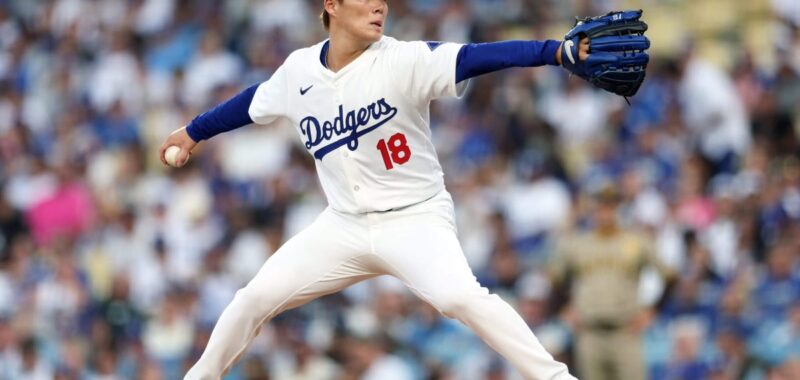LOS ANGELES – In a quiet moment last month, weeks before his Los Angeles Dodgers stared down elimination, Dave Roberts revealed his club’s position. The Dodgers’ pitching, decimated by injuries and poor performance, hadn’t materialized as envisioned.
“I’m going to go with guys I trust,” Roberts said. “It’s going to be unconventional. It has to be.”
That colored the Dodgers’ decision-making while fighting to keep their season alive on Wednesday night. They did not use a starting pitcher until Landon Knack recorded the final three outs of a shutout victory. Rather than ask Knack to save them, the Dodgers leaned into a bullpen they’ve considered to be a clear strength. Relievers have recorded 12 consecutive scoreless innings against the San Diego Padres.
.
That plan got the Dodgers to a winner-take-all Game 5. They have Yoshinobu Yamamoto lined up, the man who signed for 12 years and $325 million this past winter, the richest contract ever given to a pitcher.
Then again, he might not start.

Yoshinobu Yamamoto is lined up for Game 5, but it’s not that simple. The Dodgers could get creative with their plan. (Jayne Kamin-Oncea / Imagn Images)
Roberts, speaking Thursday, said the Dodgers are still contemplating how they’ll handle the pitching for the game that could send them to the National League Championship Series against the New York Mets.
“I flipped some coins and I couldn’t get the answer,” Padres manager Mike Shildt quipped when asked if he knew what his opponent was planning on doing. “Everybody operates their own club the way they operate it. We’re more like Vince Lombardi — power sweep, here it is, Yu Darvish is going to start, here’s our lineup.”
The Dodgers, of course, aren’t afraid of resorting to gamesmanship. They knew Freddie Freeman would not be available to play for them in Game 4, yet wrote his name in the lineup anyway before scratching him with fewer than two hours before the first pitch.
Among the pitching possibilities the Dodgers appear to be discussing, Roberts said, is running back the same formula that worked in Game 4. The manager estimated he would have “six or seven” of the seven true relievers (not including Knack) he deployed in the game available for Game 5. There are different variations of the same pitchers that Roberts can deploy, including using guys against different stacks of the lineup to minimize whatever tax they must pay for giving the Padres multiple looks. Running bullpen games every night hardly feels like a sustainable way to navigate a postseason, but the Dodgers must see a tomorrow beyond Game 5 before they can plan for it.
“But coming off of what they did last night makes everyone feel pretty confident,” Roberts said.
Even piecing together a performance like Wednesday night required optimal circumstances, including an eight-run cushion for Knack to absorb the final three outs. They’d need other ways to last for 27 outs, even if they use the same group of arms they just did.
A scenario: using Yamamoto to start and take down the first time through the opposing order while chewing up enough batters to make the rest of the outs add up with what they have out of the bullpen.
Jack Flaherty, who is on regular rest after starting Game 2, is in the mix as well after spending much of Game 4 sitting in the visiting bullpen in case the Dodgers had to break glass for an emergency.
Then there’s Yamamoto. The Dodgers reshuffled their pitching plans ahead of this series with Game 5, and him being available for it, largely in mind. The Japanese right-hander has not pitched on “regular” rest all season and would be pitching on five days’ rest for the 12th time in 20 starts (including the postseason) so far this season.
“I’m sure Yoshinobu will be a part of it,” Roberts said of the pitching plan. “How we will deploy the relievers around it if that’s the case, I just don’t know.”
Recent history provides some reason for concern about a potential start. Yamamoto allowed five runs in three innings against these same Padres in Game 1, raising his tally to 13 runs allowed against them in nine innings (three starts) this season. Roberts downplayed the results as a result of poor command rather than a poor matchup.
“When he’s convicted and ripping it and attacking hitters with his pitch mix, he’s as good as anyone,” Roberts said Thursday. “When you start kind of nibbling and getting behind, that’s when he’s not at his best.”
Yet after Game 1, Roberts theorized that Yamamoto may have been tipping his pitches with “some things with his glove.”
Yamamoto had previously dealt with pitch-tipping during spring training. The Dodgers, Roberts said, identified the issue as Yamamoto returned last month from a strained rotator cuff in his right shoulder that had kept him out for months. Everything is now “buttoned up” with the Dodgers’ prized investment, Roberts said.
Another potential landmine: navigating the first inning, particularly when it comes to neutralizing Padres superstars Fernando Tatis Jr. (who is 11-for-22 this postseason and has a 1.688 OPS in this NLDS alone) and Manny Machado. Handling those two with care, easier said than done, could swing the night.
When Yamamoto has struggled, many of those large innings have come early — including a 6.00 ERA in the first inning. An opener is among the possibilities the Dodgers are working through; Roberts said Yamamoto is “very comfortable” with the possibility of entering out of the bullpen, as he did when he threw 3 1/3 innings of relief and allowed two runs last March for Samurai Japan in the World Baseball Classic.
Then there’s the conventional option: The Dodgers invested heavily in Yamamoto for nights like this. Whether it comes with a tight leash or not, they could just let him start.
(Photo of Yoshinobu Yamamoto: Harry How / Getty Images)

